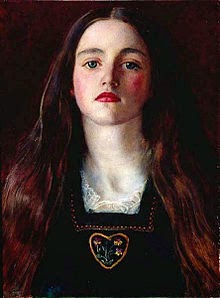We are very lucky at Hungerford Arcade to have such a good friend and writer as our brilliant Stuart Miller-Osborne. Stuart has written this remarkable story which I am sure will have you riveted as it did me. Sit down with a nice cup of tea and enjoy.
Rita
Quite
often when you stroll around the Arcade here in Hungerford or, if you
are elsewhere, you will find a book about the Pre-Raphaelite
Brotherhood which was essentially a collection of English painters
and poets and critics which was founded in 1848.
If
you are lucky, you might find a framed print of their work.
you are lucky, you might find a framed print of their work.
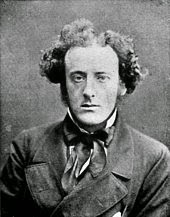 The
Thebrotherhood initially consisted of William Holman Hunt (1827-1910),
John Everett Millais (1829-1896) and Dante Gabriel Rossetti
(1828-1882).
Its
aim was to reject the approach adopted by the Mannerist
artists.They considered the classical poses and compositions
especially from Raphael to have been a corrupting influence on the
teaching of the day.
aim was to reject the approach adopted by the Mannerist
artists.They considered the classical poses and compositions
especially from Raphael to have been a corrupting influence on the
teaching of the day.
Hence
the title of the group.
the title of the group.
They
drew up a doctrine in the early days which read as follows.
drew up a doctrine in the early days which read as follows.
1/
to have genuine ideas to express
to have genuine ideas to express
2/
to study nature attentively, so as to know how to express them
(nature)
to study nature attentively, so as to know how to express them
(nature)
3/
to sympathise with what is direct and serious and heartfelt in
previous art, to the exclusion of what is conventional and
self-parodying and learned by rote
to sympathise with what is direct and serious and heartfelt in
previous art, to the exclusion of what is conventional and
self-parodying and learned by rote
4/
most indispensable of all, to produce thoroughly good picture and
statues
most indispensable of all, to produce thoroughly good picture and
statues
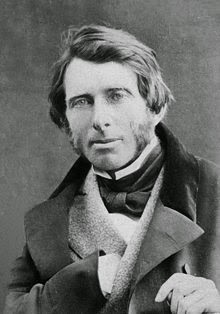 In
Inshort, it was a freedom of expression with the members being able to
express themselves without borders and by doing so, getting the work
to breathe and be approachable.
If
one looks at works by members (or later members) of the
Pre-Raphaelite Brotherhood then, I personally think that their ideas
are still attractive.
one looks at works by members (or later members) of the
Pre-Raphaelite Brotherhood then, I personally think that their ideas
are still attractive.
Although
one must have something of knowledge of their work, I feel that these
paintings still speak to us today as much as they did some one
hundred and fifty years ago.
one must have something of knowledge of their work, I feel that these
paintings still speak to us today as much as they did some one
hundred and fifty years ago.
But
what of the models. Do we ever consider the models who posed for
these famous works?
what of the models. Do we ever consider the models who posed for
these famous works?
There
are the famous ones such as Lizzie Siddal (1829-1862) who is forever
connected with Rossetti.
are the famous ones such as Lizzie Siddal (1829-1862) who is forever
connected with Rossetti.
But
who was the girl in the centre of the Millais painting, Autumn
Leaves (1856), it certainly was not the tragic Lizzie?
who was the girl in the centre of the Millais painting, Autumn
Leaves (1856), it certainly was not the tragic Lizzie?
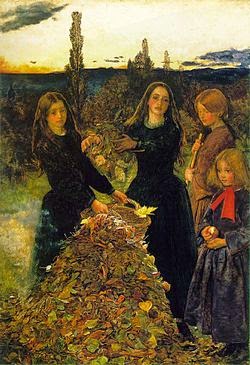 I
Ifirst saw this painting in Manchester many years ago and was struck
by the two figures to the left of the painting. Although unable to
help, the gallery assistant did point me in the direction of a book
which revealed that the models were in fact the sisters Alice and
Sophie Gray.
I
made a mental note of this and really forgot about the sisters for
many years until I saw a copy of a painting completed a year later by
Millais called simply, Portrait of a Girl.
made a mental note of this and really forgot about the sisters for
many years until I saw a copy of a painting completed a year later by
Millais called simply, Portrait of a Girl.
The
artist had used the same model as he had in Autumn Leaves and
after further research, I found this was indeed Sophie Gray
(1843-1882) whose life was equally as tragic as that of Lizzie
Siddel.
artist had used the same model as he had in Autumn Leaves and
after further research, I found this was indeed Sophie Gray
(1843-1882) whose life was equally as tragic as that of Lizzie
Siddel.
What
struck me about the portrait was the sensuality and erotic charge
that this simple painting gave to the viewer.
struck me about the portrait was the sensuality and erotic charge
that this simple painting gave to the viewer.
I
initially thought that the artist might have been the lover of the
sitter, but there is no evidence to suggest that Millais and Sophie
were ever physically involved and also, she was only fourteen when it
was painted.
initially thought that the artist might have been the lover of the
sitter, but there is no evidence to suggest that Millais and Sophie
were ever physically involved and also, she was only fourteen when it
was painted.
But
this is where my researches became interesting, as did not John
Everett Millais run off with a certain Effie Gray (1828-1897), the
wife of the famed art critic John Ruskin (1819-1900) and was Sophie
indeed related to Effie and how long had she known the artist?
this is where my researches became interesting, as did not John
Everett Millais run off with a certain Effie Gray (1828-1897), the
wife of the famed art critic John Ruskin (1819-1900) and was Sophie
indeed related to Effie and how long had she known the artist?
My
research was easy, Effie was indeed Sophie’s sister, although some
fifteen years her senior. Sophie had first met Millais in 1853 and he
had completed a rather nice oval watercolour of her in 1854.
research was easy, Effie was indeed Sophie’s sister, although some
fifteen years her senior. Sophie had first met Millais in 1853 and he
had completed a rather nice oval watercolour of her in 1854.
Indeed,
both she and Effie and her sister Alice sat for the artist.
both she and Effie and her sister Alice sat for the artist.
“…What
a delightful little shrewd damsel Sophia is…I do not praise her to
please you, but I think her extremely beautiful, and that she will
even improve, as yet she does not seem to have the slightest idea of
it herself which makes her prettier—I am afraid that ignorance
cannot last long…”
a delightful little shrewd damsel Sophia is…I do not praise her to
please you, but I think her extremely beautiful, and that she will
even improve, as yet she does not seem to have the slightest idea of
it herself which makes her prettier—I am afraid that ignorance
cannot last long…”
Indeed,
when he painted Sophie in 1857, she was as I have noted, only
fourteen but the charge of the painting hints at a much older model.
The sitter of this unusual work looks as she has attained early
adulthood.
when he painted Sophie in 1857, she was as I have noted, only
fourteen but the charge of the painting hints at a much older model.
The sitter of this unusual work looks as she has attained early
adulthood.
Sophie
occupies a large part of the canvas and is lit in a delicate fashion
from the left which highlights her golden brown hair and hints at its
auburn highlights. Her clothes are not memorable and are simply
decorated with an embroidered heart containing three flowers within.
occupies a large part of the canvas and is lit in a delicate fashion
from the left which highlights her golden brown hair and hints at its
auburn highlights. Her clothes are not memorable and are simply
decorated with an embroidered heart containing three flowers within.
I
have often thought that this simple embroidery contained a secret
message and to some extent, my enquiries continue. I believe that the
artist left a quiet message in the decoration.
have often thought that this simple embroidery contained a secret
message and to some extent, my enquiries continue. I believe that the
artist left a quiet message in the decoration.
Maybe
it is a declaration of his attraction or love for the sitter or, it
might be my own fancy and it is a simple decoration and like others I
am reading too much into it.
it is a declaration of his attraction or love for the sitter or, it
might be my own fancy and it is a simple decoration and like others I
am reading too much into it.
Sophie’s
long hair frames the portrait and mingles with the dark background.
There is a sniff of lace at her throat and her pale face contrasts
with the darker colours used.
long hair frames the portrait and mingles with the dark background.
There is a sniff of lace at her throat and her pale face contrasts
with the darker colours used.
She
stares at the viewer with her cold blue eyes which are expressionless
to the extreme. There is no clue as to what she was thinking or maybe
she is challenging the viewer to probe her thoughts (or, this might
have been Millais and Sophie’s jest who knows)?
stares at the viewer with her cold blue eyes which are expressionless
to the extreme. There is no clue as to what she was thinking or maybe
she is challenging the viewer to probe her thoughts (or, this might
have been Millais and Sophie’s jest who knows)?
Her
lips and rosy cheeks again contrast the darkness and the light of the
painting. Her lips are ruby red and are pursed in defiance and her
rosy cheeks hint at fluster. These are all enigmatic clues which
suggest things unseen.
lips and rosy cheeks again contrast the darkness and the light of the
painting. Her lips are ruby red and are pursed in defiance and her
rosy cheeks hint at fluster. These are all enigmatic clues which
suggest things unseen.
Sophie’s
chin is defiantly but subtly tilted, hinting at self-confidence
(which might again be a jest).
chin is defiantly but subtly tilted, hinting at self-confidence
(which might again be a jest).
It
is obvious that there was a connection between Millais and Sophie as
the artist has produced a very haunting portrait which celebrates the
beauty of the sitter and the fondness that he had for her.
is obvious that there was a connection between Millais and Sophie as
the artist has produced a very haunting portrait which celebrates the
beauty of the sitter and the fondness that he had for her.
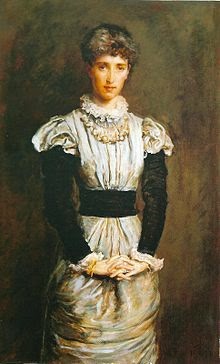 One
Onehas only to look at his paintings of the other Gray sister’s. These
are excellent works in their own right but they are just portraits.
There is no connection between the sitter and the artist and
certainly no erotic charge.
It
is well known that Millais ran off with Effie Gray and many stories
were created at the time especially the one about Ruskin’s horror
at the sight of his wife’s pubic hair.
is well known that Millais ran off with Effie Gray and many stories
were created at the time especially the one about Ruskin’s horror
at the sight of his wife’s pubic hair.
It
was really a case of two people in a marriage not hitting it off and
drifting apart.
was really a case of two people in a marriage not hitting it off and
drifting apart.
Victorian
society was easily shocked at abandonment especially if the wife
eloped with her lover, so stories were made up to cover some of
Ruskin’s peculiarities.
society was easily shocked at abandonment especially if the wife
eloped with her lover, so stories were made up to cover some of
Ruskin’s peculiarities.
Effie
was the scarlet woman who had run off with an artist,
although Millais was quite a respectable one.
was the scarlet woman who had run off with an artist,
although Millais was quite a respectable one.
On
researching this, I found out that Sophie actually helped her sister
to elope by train (Effie travelled to Scotland whereas Sophie
alighted at Hitchin where she met her father as they were to deliver
a package on to their solicitors who would forward it on to Ruskin
noting his wife’s actions).
researching this, I found out that Sophie actually helped her sister
to elope by train (Effie travelled to Scotland whereas Sophie
alighted at Hitchin where she met her father as they were to deliver
a package on to their solicitors who would forward it on to Ruskin
noting his wife’s actions).
This
package included her wedding ring and the keys to the house.
package included her wedding ring and the keys to the house.
Indeed
Ruskin came across as being a rather nice fellow who I believe,
understood in time why Effie ran off with Millais.
Ruskin came across as being a rather nice fellow who I believe,
understood in time why Effie ran off with Millais.
Others
may disagree with my thoughts, but there are always two or three ways
to look at everything.
may disagree with my thoughts, but there are always two or three ways
to look at everything.
I
personally think that if Millais had not met Effie, then he would have
married Sophie and the story that I am about to tell might not have
had such a tragic ending.
personally think that if Millais had not met Effie, then he would have
married Sophie and the story that I am about to tell might not have
had such a tragic ending.
Sophie
sadly had always been highly strung and was further damaged when she
acted as a go-between between Ruskin and Effie.
sadly had always been highly strung and was further damaged when she
acted as a go-between between Ruskin and Effie.
She
was also indulged by Ruskin’s domineering mother in an attempt to
turn her against her sister. But being loyal she kept her sister
informed of everything that was said.
was also indulged by Ruskin’s domineering mother in an attempt to
turn her against her sister. But being loyal she kept her sister
informed of everything that was said.
Sophie
began to exhibit major mental health problems in her mid-twenties and
was, in 1868 sent away from her home to stay in Chiswick under the
care of a certain Doctor Thomas Tuke who specialised in mental
health.
began to exhibit major mental health problems in her mid-twenties and
was, in 1868 sent away from her home to stay in Chiswick under the
care of a certain Doctor Thomas Tuke who specialised in mental
health.
Sadly,
conditions such as Sophie’s were often diagnosed as hysteria which
was thought to be quite common in young women.
conditions such as Sophie’s were often diagnosed as hysteria which
was thought to be quite common in young women.
What
is known, is that Sophie suffered from Anorexia Nervosa which
contributed to her overall condition.
is known, is that Sophie suffered from Anorexia Nervosa which
contributed to her overall condition.
.
In
1873 she married (unhappily it turned out), to a Scottish Jute
manufacturer James Key Caird.
1873 she married (unhappily it turned out), to a Scottish Jute
manufacturer James Key Caird.
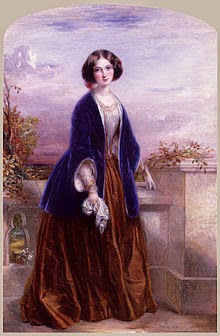 He
Hewas wealthy but neglected Sophie when she needed him most. They had a
child Beatrix Ada (who was later painted by Rossetti) and she lived
mostly alone with her daughter in Dundee and Paris.
As
with patient’s suffering from this condition, she lost weight
rapidly and her health deteriorated and she was again committed to
the care of Doctor Tuke, but she never really recovered and passed
away on the 15th of March 1882.
with patient’s suffering from this condition, she lost weight
rapidly and her health deteriorated and she was again committed to
the care of Doctor Tuke, but she never really recovered and passed
away on the 15th of March 1882.
Her
cause of death was recorded mysteriously as exhaustion and
atrophy of the nervous system.
cause of death was recorded mysteriously as exhaustion and
atrophy of the nervous system.
There
were rumours of suicide but these were never really followed up.
were rumours of suicide but these were never really followed up.
I
would like to think that given the right circumstances, Sophie might
have been able to conquer or at least live with her demons and a late
portrait by Millais painted in 1880, shows a much different Sophie.
would like to think that given the right circumstances, Sophie might
have been able to conquer or at least live with her demons and a late
portrait by Millais painted in 1880, shows a much different Sophie.
She
has aged and looks older than her thirty-seven years. Her once
luxurious hair is showing evidence of greyness and is tightly wound.
has aged and looks older than her thirty-seven years. Her once
luxurious hair is showing evidence of greyness and is tightly wound.
Sophie’s
posture is nervous almost insular and she bends her fingers with
nervous impression. She is dressed modestly and could almost be a
spinster hidden away in the shadows.
posture is nervous almost insular and she bends her fingers with
nervous impression. She is dressed modestly and could almost be a
spinster hidden away in the shadows.
Her
colours are sombre and Millais has almost created a ghost like figure
in complete contrast with the sensuous portrait painted some
twenty-three years previously.
colours are sombre and Millais has almost created a ghost like figure
in complete contrast with the sensuous portrait painted some
twenty-three years previously.
It
is one of the most tragic of his works and in my view, should be hung
next to the 1857 portrait but this unlikely to happen.
is one of the most tragic of his works and in my view, should be hung
next to the 1857 portrait but this unlikely to happen.
Other
interesting facts I found whilst researching this article was that
sadly, Sophie’s daughter died in 1888 at exactly the same age as
her mother had been when she sat for the famous portrait. .
interesting facts I found whilst researching this article was that
sadly, Sophie’s daughter died in 1888 at exactly the same age as
her mother had been when she sat for the famous portrait. .
Her
husband, although neglectful of Sophie, helped to fund Ernest
Shackleton’s Trans-Antarctic expedition (1914-1917) and was a major
benefactor to the city of Dundee.
husband, although neglectful of Sophie, helped to fund Ernest
Shackleton’s Trans-Antarctic expedition (1914-1917) and was a major
benefactor to the city of Dundee.
Although
he has been painted as being neglectful of Sophie, the death of his
wife and his daughter within six years of each other seemed to have
hit James Caird hard and he became increasingly philanthropic in his
later years (he died in 1916).
he has been painted as being neglectful of Sophie, the death of his
wife and his daughter within six years of each other seemed to have
hit James Caird hard and he became increasingly philanthropic in his
later years (he died in 1916).
He
contributed £18,500 to the Dundee Royal Infirmary so that they could
erect a hospital for the treatment of cancer. This was one of his
many generous gifts to the city.
contributed £18,500 to the Dundee Royal Infirmary so that they could
erect a hospital for the treatment of cancer. This was one of his
many generous gifts to the city.
I
believe that James was just a typical Victorian businessman but in
Sophie’s case, his neglect was not helpful. Maybe he did not fully
understand Sophie’s condition and the dangers it presented.
believe that James was just a typical Victorian businessman but in
Sophie’s case, his neglect was not helpful. Maybe he did not fully
understand Sophie’s condition and the dangers it presented.
If
I had the funds available (and if the present owners would sell), I
would purchase Sophie’s 1857 portrait and loan it to a gallery so
that visitors could examine this astonishing work and maybe try to
discover some of its secrets.
I had the funds available (and if the present owners would sell), I
would purchase Sophie’s 1857 portrait and loan it to a gallery so
that visitors could examine this astonishing work and maybe try to
discover some of its secrets.
It
is one of the most enigmatic of paintings.
is one of the most enigmatic of paintings.
Stuart Miller-Osborne
For all the latest news, go to our Newsletter at www.hungerfordarcade.co.uk

